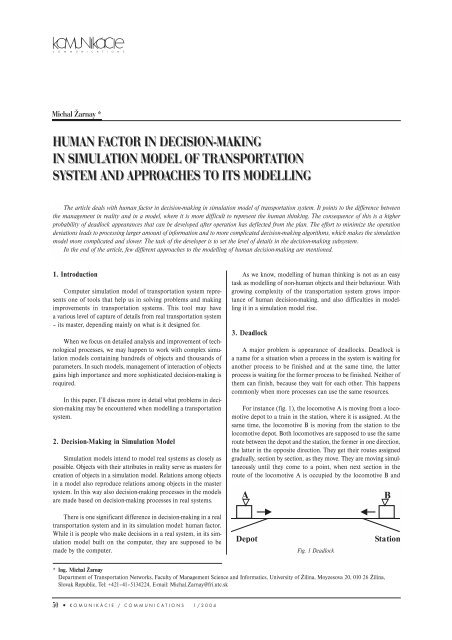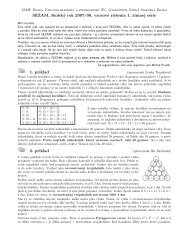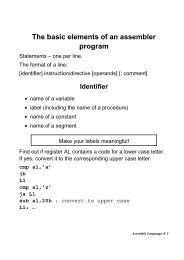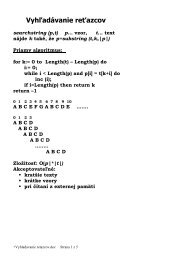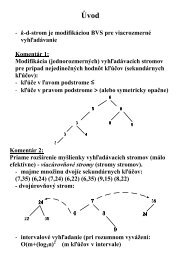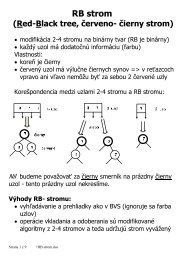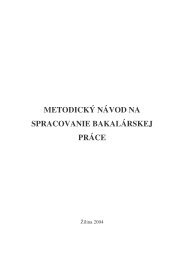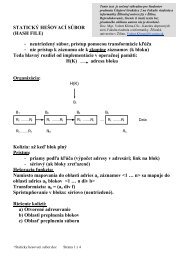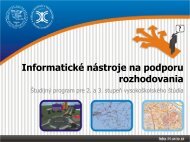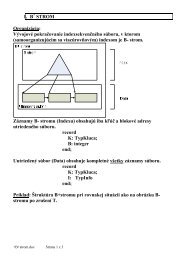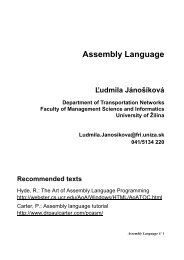human factor in decision-making in simulation model of ...
human factor in decision-making in simulation model of ...
human factor in decision-making in simulation model of ...
Create successful ePaper yourself
Turn your PDF publications into a flip-book with our unique Google optimized e-Paper software.
C O M M U N II C A TT II O N SS<br />
Michal Žarnay *<br />
HUMAN FACTOR IN DECISION-MAKING<br />
IN SIMULATION MODEL OF TRANSPORTATION<br />
SYSTEM AND APPROACHES TO ITS MODELLING<br />
The article deals with <strong>human</strong> <strong>factor</strong> <strong>in</strong> <strong>decision</strong>-mak<strong>in</strong>g <strong>in</strong> <strong>simulation</strong> <strong>model</strong> <strong>of</strong> transportation system. It po<strong>in</strong>ts to the difference between<br />
the management <strong>in</strong> reality and <strong>in</strong> a <strong>model</strong>, where it is more difficult to represent the <strong>human</strong> th<strong>in</strong>k<strong>in</strong>g. The consequence <strong>of</strong> this is a higher<br />
probability <strong>of</strong> deadlock appearances that can be developed after operation has deflected from the plan. The effort to m<strong>in</strong>imize the operation<br />
deviations leads to process<strong>in</strong>g larger amount <strong>of</strong> <strong>in</strong>formation and to more complicated <strong>decision</strong>-mak<strong>in</strong>g algorithms, which makes the <strong>simulation</strong><br />
<strong>model</strong> more complicated and slower. The task <strong>of</strong> the developer is to set the level <strong>of</strong> details <strong>in</strong> the <strong>decision</strong>-mak<strong>in</strong>g subsystem.<br />
In the end <strong>of</strong> the article, few different approaches to the <strong>model</strong>l<strong>in</strong>g <strong>of</strong> <strong>human</strong> <strong>decision</strong>-mak<strong>in</strong>g are mentioned.<br />
1. Introduction<br />
Computer <strong>simulation</strong> <strong>model</strong> <strong>of</strong> transportation system represents<br />
one <strong>of</strong> tools that help us <strong>in</strong> solv<strong>in</strong>g problems and mak<strong>in</strong>g<br />
improvements <strong>in</strong> transportation systems. This tool may have<br />
avarious level <strong>of</strong> capture <strong>of</strong> details from real transportation system<br />
– its master, depend<strong>in</strong>g ma<strong>in</strong>ly on what is it designed for.<br />
When we focus on detailed analysis and improvement <strong>of</strong> technological<br />
processes, we may happen to work with complex <strong>simulation</strong><br />
<strong>model</strong>s conta<strong>in</strong><strong>in</strong>g hundreds <strong>of</strong> objects and thousands <strong>of</strong><br />
parameters. In such <strong>model</strong>s, management <strong>of</strong> <strong>in</strong>teraction <strong>of</strong> objects<br />
ga<strong>in</strong>s high importance and more sophisticated <strong>decision</strong>-mak<strong>in</strong>g is<br />
required.<br />
In this paper, I’ll discuss more <strong>in</strong> detail what problems <strong>in</strong> <strong>decision</strong>-mak<strong>in</strong>g<br />
may be encountered when <strong>model</strong>l<strong>in</strong>g a transportation<br />
system.<br />
2. Decision-Mak<strong>in</strong>g <strong>in</strong> Simulation Model<br />
Simulation <strong>model</strong>s <strong>in</strong>tend to <strong>model</strong> real systems as closely as<br />
possible. Objects with their attributes <strong>in</strong> reality serve as masters for<br />
creation <strong>of</strong> objects <strong>in</strong> a <strong>simulation</strong> <strong>model</strong>. Relations among objects<br />
<strong>in</strong> a <strong>model</strong> also reproduce relations among objects <strong>in</strong> the master<br />
system. In this way also <strong>decision</strong>-mak<strong>in</strong>g processes <strong>in</strong> the <strong>model</strong>s<br />
are made based on <strong>decision</strong>-mak<strong>in</strong>g processes <strong>in</strong> real systems.<br />
There is one significant difference <strong>in</strong> <strong>decision</strong>-mak<strong>in</strong>g <strong>in</strong> a real<br />
transportation system and <strong>in</strong> its <strong>simulation</strong> <strong>model</strong>: <strong>human</strong> <strong>factor</strong>.<br />
While it is people who make <strong>decision</strong>s <strong>in</strong> a real system, <strong>in</strong> its <strong>simulation</strong><br />
<strong>model</strong> built on the computer, they are supposed to be<br />
made by the computer.<br />
50 ● K OMUNIKÁCIE / COMMUNICATIONS 1/2004<br />
As we know, <strong>model</strong>l<strong>in</strong>g <strong>of</strong> <strong>human</strong> th<strong>in</strong>k<strong>in</strong>g is not as an easy<br />
task as <strong>model</strong>l<strong>in</strong>g <strong>of</strong> non-<strong>human</strong> objects and their behaviour. With<br />
grow<strong>in</strong>g complexity <strong>of</strong> the transportation system grows importance<br />
<strong>of</strong> <strong>human</strong> <strong>decision</strong>-mak<strong>in</strong>g, and also difficulties <strong>in</strong> <strong>model</strong>l<strong>in</strong>g<br />
it <strong>in</strong> a <strong>simulation</strong> <strong>model</strong> rise.<br />
3. Deadlock<br />
A major problem is appearance <strong>of</strong> deadlocks. Deadlock is<br />
a name for a situation when a process <strong>in</strong> the system is wait<strong>in</strong>g for<br />
another process to be f<strong>in</strong>ished and at the same time, the latter<br />
process is wait<strong>in</strong>g for the former process to be f<strong>in</strong>ished. Neither <strong>of</strong><br />
them can f<strong>in</strong>ish, because they wait for each other. This happens<br />
commonly when more processes can use the same resources.<br />
For <strong>in</strong>stance (fig. 1), the locomotive A is mov<strong>in</strong>g from a locomotive<br />
depot to a tra<strong>in</strong> <strong>in</strong> the station, where it is assigned. At the<br />
same time, the locomotive B is mov<strong>in</strong>g from the station to the<br />
locomotive depot. Both locomotives are supposed to use the same<br />
route between the depot and the station, the former <strong>in</strong> one direction,<br />
the latter <strong>in</strong> the opposite direction. They get their routes assigned<br />
gradually, section by section, as they move. They are mov<strong>in</strong>g simultaneously<br />
until they come to a po<strong>in</strong>t, when next section <strong>in</strong> the<br />
route <strong>of</strong> the locomotive A is occupied by the locomotive B and<br />
Fig. 1 Deadlock<br />
* Ing. Michal Žarnay<br />
Department <strong>of</strong> Transportation Networks, Faculty <strong>of</strong> Management Science and Informatics, University <strong>of</strong> Žil<strong>in</strong>a, Moyzesova 20, 010 26 Žil<strong>in</strong>a,<br />
Slovak Republic, Tel: +421–41–5134224, E-mail: Michal.Zarnay@fri.utc.sk
next section <strong>in</strong> the route <strong>of</strong> the locomotive B is taken by the locomotive<br />
A. They stop to wait for their resources to be assigned. And<br />
if they have no alternatives for movement, they can wait forever –<br />
they are <strong>in</strong> deadlock.<br />
4. Plan and Management<br />
In most transportation systems (e.g. railway station, airport,<br />
local bus network), an operation is planned <strong>in</strong> advance. A plan<br />
assumes time po<strong>in</strong>ts when events will happen and conta<strong>in</strong>s actions<br />
that should follow the events <strong>in</strong> context <strong>of</strong> current situation.<br />
Because <strong>of</strong> stochastic <strong>in</strong>fluence, events do not happen always<br />
accord<strong>in</strong>g to the plan. Thus deviations from the plan appear – e.g.<br />
deviations <strong>in</strong> time or <strong>in</strong> selection <strong>of</strong> used resources.<br />
Fig. 2 Stochastic <strong>in</strong>fluence and operative management<br />
<strong>in</strong> transportttion<br />
In this situation, it is a task <strong>of</strong> an operative management subsystem<br />
to adapt the plan to the reality. It must take such actions<br />
that the system comes back to the plan. If there are enough<br />
resources to cope with the deviation (time reserves, available personnel<br />
or equipment), the management subsystem can remove the<br />
deviations and br<strong>in</strong>g the system back to the plan. If any <strong>of</strong> required<br />
resources fails, the deviation may grow, and come to a deadlock<br />
eventually (fig. 2).<br />
For <strong>in</strong>stance, <strong>in</strong> a railway station, the plan is represented by<br />
a timetable that predicts events <strong>of</strong> departures and arrivals <strong>of</strong> tra<strong>in</strong>s.<br />
Based on this, plans <strong>of</strong> correspond<strong>in</strong>g technological processes and<br />
services to passengers are developed. In this way, employees at the<br />
station know when the tra<strong>in</strong> should be shunted, cleaned, or <strong>in</strong>spected.<br />
Each employee has an <strong>in</strong>dividual work<strong>in</strong>g plan with a list <strong>of</strong><br />
time po<strong>in</strong>ts and tra<strong>in</strong> numbers to work on.<br />
Stochastic <strong>in</strong>fluence causes that tra<strong>in</strong>s may run late, cargo<br />
tra<strong>in</strong>s may conta<strong>in</strong> more loaded cars, or any cars for special manipulation,<br />
or unexpected failures may cause delay <strong>of</strong> technological<br />
operations.<br />
C O M M U N II C A TT II O N SS<br />
The deviations <strong>in</strong> this example could be: us<strong>in</strong>g a track that<br />
was not planned for the given tra<strong>in</strong>, delay <strong>in</strong> process<strong>in</strong>g <strong>of</strong> the<br />
tra<strong>in</strong> or us<strong>in</strong>g another personnel group for certa<strong>in</strong> operation than<br />
orig<strong>in</strong>ally planned.<br />
5. Problem <strong>in</strong> Modell<strong>in</strong>g <strong>of</strong> Human Decision-Mak<strong>in</strong>g<br />
In a real transportation system, the management subsystem<br />
conta<strong>in</strong>s <strong>human</strong> <strong>factor</strong>, which is able to spot deviations that may<br />
lead later to a deadlock. This person monitors the system and does<br />
necessary operations to keep it runn<strong>in</strong>g closely to the plan.<br />
In a <strong>simulation</strong> <strong>model</strong>, <strong>in</strong> most cases, the <strong>human</strong> be<strong>in</strong>g <strong>in</strong> the<br />
management subsystem is replaced by computer logic. The subsystem<br />
conta<strong>in</strong>s also tools for monitor<strong>in</strong>g the system and for perform<strong>in</strong>g<br />
necessary operations. These are prescribed <strong>in</strong> a form <strong>of</strong><br />
algorithms by a <strong>human</strong> be<strong>in</strong>g <strong>in</strong> advance. Each algorithm is supposed<br />
to make a <strong>decision</strong> <strong>in</strong> a given situation. The situation is<br />
recognised from available <strong>in</strong>formation about the current situation<br />
<strong>in</strong> the system. Based on it, a <strong>decision</strong> is made.<br />
Quality <strong>of</strong> the <strong>decision</strong> depends on two <strong>factor</strong>s: quality <strong>of</strong><br />
processed <strong>in</strong>formation and quality <strong>of</strong> <strong>decision</strong>-mak<strong>in</strong>g algorithm.<br />
The processed <strong>in</strong>formation must conta<strong>in</strong> basic data that is absolutely<br />
necessary for the <strong>decision</strong>-mak<strong>in</strong>g. It can also conta<strong>in</strong> additional<br />
<strong>in</strong>formation that can <strong>in</strong>fluence quality <strong>of</strong> the solution. Similarly,<br />
the <strong>decision</strong>-mak<strong>in</strong>g algorithm must conta<strong>in</strong> some absolutely necessary<br />
m<strong>in</strong>imum to make the requested <strong>decision</strong>. To ensure higher<br />
quality <strong>of</strong> solution, the algorithm may be also more sophisticated<br />
and conta<strong>in</strong> mechanisms for process<strong>in</strong>g additional <strong>in</strong>formation and<br />
evaluat<strong>in</strong>g additional criteria when choos<strong>in</strong>g a <strong>decision</strong>.<br />
Let’s see an example (fig.3). Passenger tra<strong>in</strong> No. 340 comes<br />
to a tra<strong>in</strong> station delayed. Accord<strong>in</strong>g to the plan, it is supposed to<br />
use the platform track No. 3 <strong>in</strong> the station. However, at its delayed<br />
arrival another tra<strong>in</strong> No. 2801 should occupy the track. To solve<br />
this conflict, an additional track must be used.<br />
Fig. 3 Example <strong>of</strong> conflict situation<br />
We have two options: platform tracks No. 2 or No. 4. This<br />
<strong>in</strong>formation (list <strong>of</strong> additional tracks for use) is the necessary<br />
m<strong>in</strong>imum to solve the situation. A simple algorithm may use the<br />
First-In-First-Out method. Accord<strong>in</strong>g to this the tra<strong>in</strong> No. 340, as<br />
com<strong>in</strong>g later, will use the track No. 2, which is selected as the first<br />
<strong>in</strong> the list.<br />
However, as consequence <strong>of</strong> this <strong>decision</strong>, the evident deviation<br />
from the plan may be spread further to other tra<strong>in</strong>s and tracks,<br />
K OMUNIKÁCIE / COMMUNICATIONS 1/2004 ●<br />
51
C O M M U N II C A TT II O N SS<br />
because use <strong>of</strong> the track No. 2 will <strong>in</strong>fluence the process<strong>in</strong>g <strong>of</strong><br />
another tra<strong>in</strong> planned for that track. Another <strong>decision</strong>, use <strong>of</strong> the<br />
track No. 4 <strong>in</strong> this case, could have other consequences. It could<br />
spread the deviations from the plan to other parts <strong>of</strong> the <strong>model</strong> as<br />
well, more or less than the former <strong>decision</strong>. Our simple algorithm<br />
does not compare them.<br />
If additional <strong>in</strong>formation about consequences was available or<br />
the <strong>decision</strong>-mak<strong>in</strong>g algorithm processed available <strong>in</strong>formation <strong>in</strong><br />
more sophisticated way, another solution could be chosen br<strong>in</strong>g<strong>in</strong>g<br />
the deviation closer to its end <strong>in</strong> near future. In this example, it<br />
could use <strong>in</strong>formation from the occupation plan <strong>of</strong> the platform<br />
tracks No. 2 and No. 4 <strong>in</strong> the next 10 m<strong>in</strong>utes, or check how<br />
modified routes <strong>of</strong> tra<strong>in</strong>s through the station will <strong>in</strong>fluence other<br />
movements. This <strong>in</strong>formation could be compared with additional<br />
criteria for use <strong>of</strong> the platform tracks and for movements <strong>in</strong> the<br />
station planned <strong>in</strong> the near future. Results <strong>of</strong> this evaluation could<br />
contribute to the selection <strong>of</strong> one <strong>of</strong> the two alternatives.<br />
It is obvious that mak<strong>in</strong>g <strong>decision</strong>s <strong>of</strong> better quality would<br />
require more <strong>in</strong>formation <strong>in</strong> the phase <strong>of</strong> monitor<strong>in</strong>g or more<br />
detailed process<strong>in</strong>g <strong>of</strong> available <strong>in</strong>formation <strong>in</strong> the phase <strong>of</strong> <strong>decision</strong>mak<strong>in</strong>g<br />
(fig. 4). However, the more parameters a <strong>simulation</strong> <strong>model</strong><br />
has, the larger is variety <strong>of</strong> different situations to solve, the more<br />
sensitive is <strong>model</strong> to stochastic events and probability <strong>of</strong> deadlocks<br />
is higher.<br />
Fig. 4 Phases <strong>of</strong> focus when improv<strong>in</strong>g <strong>decision</strong>-mak<strong>in</strong>g<br />
In order to prevent a complex <strong>simulation</strong> <strong>model</strong> from deadlocks<br />
and to keep it <strong>in</strong> l<strong>in</strong>e with the plan, requirements on the<br />
computer management subsystem are higher which means a larger<br />
scale <strong>of</strong> <strong>in</strong>formation needed for <strong>decision</strong>-mak<strong>in</strong>g and more complicated<br />
algorithms. Both aspects require deeper knowledge <strong>of</strong><br />
management subsystem <strong>in</strong> the transportation system by a <strong>simulation</strong><br />
<strong>model</strong> designer. Information from more sources <strong>in</strong> the <strong>model</strong><br />
and more ways <strong>of</strong> comb<strong>in</strong><strong>in</strong>g it must be taken <strong>in</strong>to account.<br />
Apart from that <strong>decision</strong>-mak<strong>in</strong>g processes last longer and<br />
require more comput<strong>in</strong>g power. This makes <strong>simulation</strong> <strong>model</strong>s<br />
slower.<br />
52 ● K OMUNIKÁCIE / COMMUNICATIONS 1/2004<br />
6. Possible Approaches <strong>in</strong> Modell<strong>in</strong>g <strong>of</strong> Human<br />
Decision-Mak<strong>in</strong>g<br />
There is a wide range <strong>of</strong> possible approaches for solv<strong>in</strong>g this<br />
issue: from application <strong>of</strong> exact algorithms (e.g. from mathematical<br />
programm<strong>in</strong>g), through heuristic algorithms to application <strong>of</strong><br />
artificial <strong>in</strong>telligence with fuzzy logic. It can be also a comb<strong>in</strong>ation<br />
<strong>of</strong> all.<br />
Exact algorithms can be used <strong>in</strong> only a small extent <strong>of</strong> situations,<br />
s<strong>in</strong>ce their application usually requires unacceptable simplification<br />
<strong>of</strong> the problem or they need too long time to come to<br />
a solution, or both. That is why heuristic algorithms and artificial<br />
<strong>in</strong>telligence are applied <strong>in</strong> most <strong>of</strong> the cases.<br />
In the described area, <strong>in</strong> our department, so far we have used<br />
the exact algorithms for solv<strong>in</strong>g simple problems. For complicated<br />
<strong>decision</strong>-mak<strong>in</strong>g situations, heuristic algorithms are used. The development<br />
goes on and we are improv<strong>in</strong>g heuristic algorithms and<br />
<strong>in</strong>vestigat<strong>in</strong>g the area <strong>of</strong> artificial <strong>in</strong>telligence.<br />
Another way that can help <strong>in</strong> solv<strong>in</strong>g, is <strong>model</strong>l<strong>in</strong>g with help<br />
<strong>of</strong> Petri Nets. This formal tool allows not only <strong>model</strong>l<strong>in</strong>g, but also<br />
<strong>simulation</strong> and analysis <strong>of</strong> the <strong>model</strong>led system. There are different<br />
classes <strong>of</strong> Petri Nets used <strong>in</strong> different cases, e.g. coloured Petri<br />
Nets, timed Petri Nets or fuzzy Petri Nets.<br />
An idea that we would like to <strong>in</strong>vestigate is to use coloured<br />
Petri Nets and their analysis space for solv<strong>in</strong>g <strong>in</strong>dividual <strong>decision</strong>mak<strong>in</strong>g<br />
situations that will be extracted from the <strong>model</strong>led system.<br />
It is also possible that for representation <strong>of</strong> facts and rules for<br />
<strong>decision</strong>-mak<strong>in</strong>g, fuzzy logic will be used.<br />
7. Conclusion<br />
Aresult <strong>of</strong> the development <strong>of</strong> management subsystem to<br />
a more complex version is its complexity and slower speed <strong>of</strong> the<br />
<strong>simulation</strong> <strong>model</strong>. This can harm some <strong>of</strong> the advantages <strong>of</strong> <strong>simulation</strong><br />
<strong>model</strong>s: speed and clarity.<br />
In this way, a <strong>simulation</strong> <strong>model</strong> designer is between two<br />
extreme approaches lead<strong>in</strong>g to:<br />
● On one side a faster and clearer <strong>model</strong> with simpler management<br />
subsystem, but with more difficult task <strong>of</strong> manag<strong>in</strong>g stochastic<br />
events <strong>in</strong> the <strong>model</strong> (deviations from plan),<br />
● On the other side a more robust <strong>model</strong> able to deal with more<br />
various situations as results <strong>of</strong> stochastic events, but slower with<br />
more complex management subsystem.<br />
It is a task for a designer to f<strong>in</strong>d a compromise between the<br />
two approaches and to def<strong>in</strong>e how close the compromise will be<br />
to any <strong>of</strong> them. This compromise depends most <strong>of</strong>ten on goal(s)<br />
carried out by <strong>simulation</strong>.<br />
Possible approaches <strong>in</strong> <strong>model</strong>l<strong>in</strong>g <strong>of</strong> <strong>human</strong> <strong>decision</strong>-mak<strong>in</strong>g<br />
are various. One <strong>of</strong> them, connected with application <strong>of</strong> Petri<br />
Nets, is to be <strong>in</strong>vestigated.
References:<br />
C O M M U N II C A TT II O N SS<br />
[1] ŽARNAY, M.: Decision-mak<strong>in</strong>g support <strong>in</strong> <strong>simulation</strong> <strong>model</strong>s <strong>of</strong> nodes <strong>of</strong> railway network. Perner’s Contact 2001, Pardubice, 2001<br />
[2] ŽARNAY, M.: Analysis <strong>of</strong> <strong>decision</strong>-mak<strong>in</strong>g <strong>in</strong> <strong>simulation</strong> <strong>model</strong> <strong>of</strong> node <strong>of</strong> railway network. Perner’s Contact 2001, Pardubice, 2001<br />
[3] KAVIČKA, A., KLIMA, V.: Interactive problem solv<strong>in</strong>g <strong>in</strong> <strong>simulation</strong> <strong>model</strong> <strong>of</strong> marshall<strong>in</strong>g yard operation. In: Proceed<strong>in</strong>gs <strong>of</strong> the 3rd<br />
<strong>in</strong>ternational symposium “ŽEL 96”, Žil<strong>in</strong>a, 1996, pp. 229-233<br />
[4] KLIMA, V., KAVIČKA, A.: Agent-based <strong>simulation</strong> <strong>model</strong> design. In: Proceed<strong>in</strong>gs <strong>of</strong> European <strong>simulation</strong> multiconference, SCS<br />
Budapest, 1996, pp. 254-258.<br />
K OMUNIKÁCIE / COMMUNICATIONS 1/2004 ●<br />
53


